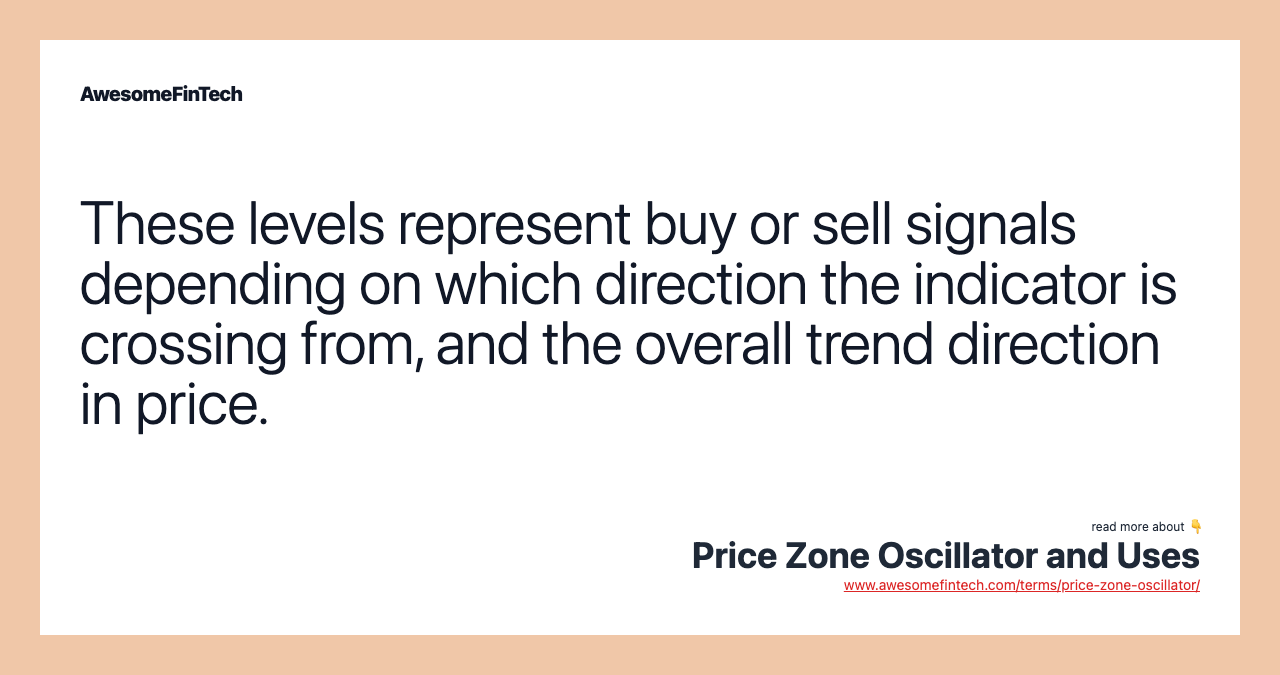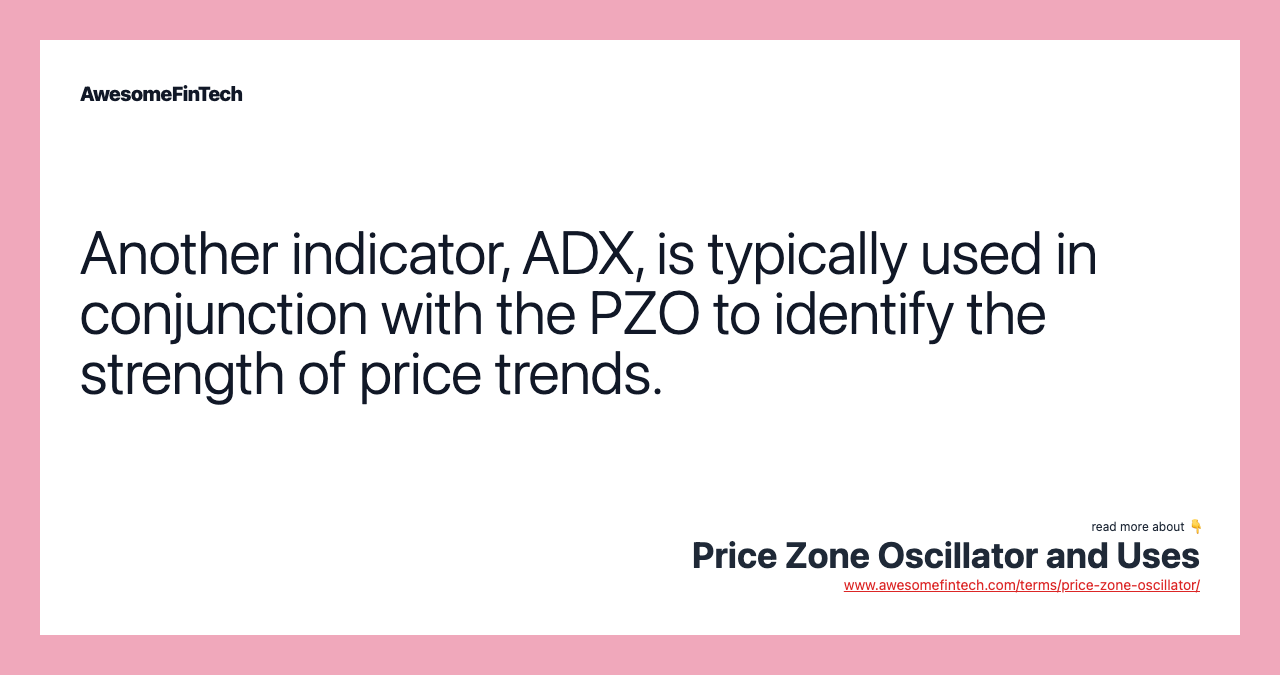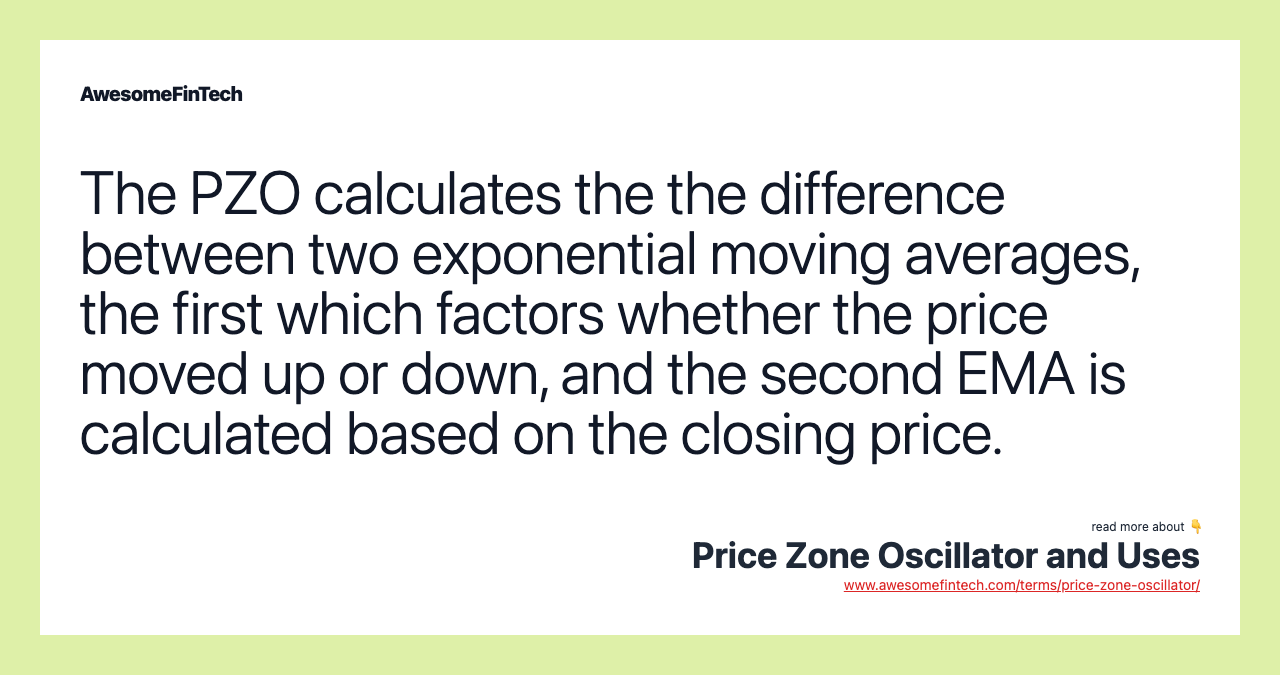Price Zone Oscillator and Uses
The price zone oscillator has key levels at 15, 40, 60, -5, -40, and -60. These levels represent buy or sell signals depending on which direction the indicator is crossing from, and the overall trend direction in price. Another indicator, ADX, is typically used in conjunction with the PZO to identify the strength of price trends. The PZO calculates the the difference between two exponential moving averages, the first which factors whether the price moved up or down, and the second EMA is calculated based on the closing price. The oscillator can be calculated using the formula: Oscillator \= 100 ( C P T C ) where: C P (Closing Position) \= n \-period EMA ( \+ \-close ) T C (Total Close ) \= n \-period EMA (close) \\begin{aligned}&\\text{Price~Zone~Oscillator} = 100\\left(\\frac{CP}{TC}\\right)\\\\&\\textbf{where:}\\\\&CP\\text{ (Closing Position)}=n\\text{-period EMA} (+\\text{-close})\\\\&TC \\text{ (Total Close})= n\\text{-period EMA (close)}\\end{aligned} Price Zone Oscillator\=100(TCCP)where:CP (Closing Position)\=n\-period EMA(+\-close)TC (Total Close)\=n\-period EMA (close) Here's how to calculate the Price Zone Oscillator, as it involves several steps. 1. Determine the sign for the day, + or -. The zero line can also be used to open or close positions depending on whether there is an uptrend or downtrend (ADX>18) present. Traders could also come up with their own rules for how to interpret and use the indicator. The following chart shows a 21-day PZO applied to Facebook (FB) stock.  Image by Sabrina Jiang © Investopedia 2021 The Relative Strength Index (RSI) is another oscillator and momentum indicator that compares the magnitude of recent price moves to prior price moves. +15: When the PZO crosses this level from below, consider buying if it is a non-trending market (ADX<18). \-5: When the PZO crosses this level from above, consider shorting if the asset is not trending (ADX<18)

What Is Price Zone Oscillator?
The Price Zone Oscillator (PZO) is a technical indicator that measures the current price versus averaged historical prices. The indicator calculates two exponential moving averages and is the ratio between them. Like other oscillators it helps identify potential overbought and oversold levels which may indicate selling or buying opportunities.




Calculating the Price Zone Oscillator
The oscillator can be calculated using the formula:
Price Zone Oscillator = 100 ( C P T C ) where: C P (Closing Position) = n -period EMA ( + -close ) T C (Total Close ) = n -period EMA (close) \begin{aligned}&\text{Price~Zone~Oscillator} = 100\left(\frac{CP}{TC}\right)\\&\textbf{where:}\\&CP\text{ (Closing Position)}=n\text{-period EMA} (+\text{-close})\\&TC \text{ (Total Close})= n\text{-period EMA (close)}\end{aligned} Price Zone Oscillator=100(TCCP)where:CP (Closing Position)=n-period EMA(+-close)TC (Total Close)=n-period EMA (close)
How to Calculate the Price Zone Oscillator
Here's how to calculate the Price Zone Oscillator, as it involves several steps.
- Determine the sign for the day, + or -. If the close is above the prior close, it is positive. Below it is negative.
- Calculate the Digital Value: = sign(close-close-1)
- Calculate CP, which is the EMA of the digital value over n periods.
- Calculate TC which is the EMA of the closing prices over n periods.
- Calculate PZO: 100*(CP / TC)
What the Price Zone Oscillator Tells You
The indicator is calculated as a percentage ratio between two exponential moving averages (EMAs) and is used by traders and market timers to identify overbought or oversold conditions, as well as potential reversal opportunities.
The highest possible value is 100 and the lowest possible value is -100, but traders also watch key levels in between for trade signals (discussed below).
Exponential moving averages are used to smooth out the Price Zone Oscillator rather than simply using raw prices.
Using the Price Zone Oscillator
Traders use the Price Zone Oscillator like any other oscillator by looking for overbought or oversold. According to the author’s original article appearing in the Technical Analysis of Stocks and Commodities magazine, the oscillator’s key levels to watch include -60, -40, -5, +15, +40, and +60.
Most traders use the Price Zone Oscillator in conjunction with other technical indicators or chart patterns, such as the Average Directional Index (ADX), which measures the potential strength of trends. The author's original article described several buy and sell guidelines based on using the PZO and ADX together.
Traders could also come up with their own rules for how to interpret and use the indicator.
The following chart shows a 21-day PZO applied to Facebook (FB) stock.
Image by Sabrina Jiang © Investopedia 2021
The Price Zone Oscillator Versus the Relative Strength Index
The Relative Strength Index (RSI) is another oscillator and momentum indicator that compares the magnitude of recent price moves to prior price moves. It also provides overbought and oversold levels, typically at 70 or 80, and 20 or 30, respectively.
Limitations of the Price Zone Oscillator
The PZO was built around being used with other indicators, which means it may not be useful on its own.
There tends to be a lot of activity around the zero line, which may make it difficult to decipher valid signals in this region. Also, since the indicator can be quite choppy, the other levels experience similar problems, but usually to a lesser degree.
There is nothing inherently predictive about the indicator. It is calculating past data. It is a lagging indicator. The indicator is best used in conjunction with other forms of analysis, and filtered with other indicators.
Related terms:
Average Directional Index (ADX)
The average directional index (ADX) helps traders see the trend direction as well as the strength of that trend. read more
Chande Momentum Oscillator
The Chande momentum oscillator is a technical momentum indicator that calculates relative strength or weakness over a user-defined time frame. read more
Data Smoothing
Data smoothing is done by using an algorithm to remove noise from a data set. This allows important patterns to stand out. read more
Exponential Moving Average (EMA)
An exponential moving average (EMA) is a type of moving average that places a greater weight and significance on the most recent data points. read more
What Is an Indicator?
Indicators are statistics used to measure current conditions as well as to forecast trends. Learn how investors use economic and technical indicators. read more
Klinger Oscillator
The Klinger Oscillator is a technical indicator that combines prices movements with volume. The indicator uses divergence and crossovers to generate trade signals. read more
Lagging Indicator
A lagging indicator is an observable or measurable factor that changes some time after the economic, financial, or business variable it is correlated with changes. read more
Moving Average Convergence Divergence (MACD)
Moving Average Convergence Divergence (MACD) is defined as a trend-following momentum indicator that shows the relationship between two moving averages of a security's price. read more
Oscillator
An oscillator is a technical indicator that tends to revert to a mean, and so can signal trend reversals. read more
Overbought
Overbought refers to a security that traders believe is priced above its true value and that will likely face corrective downward pressure in the near future. read more